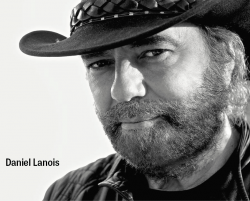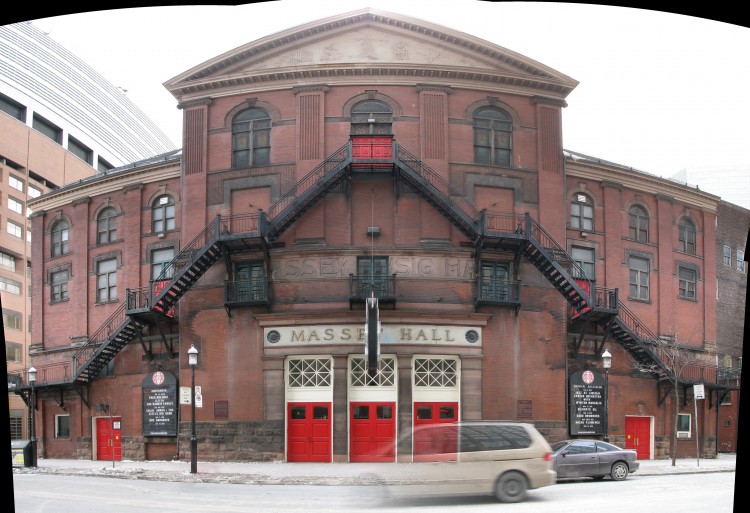 As bodies begin to fill the sea of burgundy and beige chairs in legendary Massey Hall, the excitement for tonight’s show is palpable. Daniel Lanois has the opening slot for Emmylou Harris at the end of their tour celebrating the reissue of 1995’s Wrecking Ball, for which Lanois also owns producing credit. As I watch the diverse crowd trickle in, the instrumental pre show music seeping out from surrounding speakers catches me. I think it is Lanois’ music but I can’t say for sure. That guess is put to rest as Lanois appears on stage walking with purpose and perfect timing to be seated at his pedal steel. There is a smooth transition from the speakers into a live continuation. Everyone’s focus has redirected and for the first time since I can remember, there is not one illuminated cellphone in my peripheral. This crowd is here to listen.
As bodies begin to fill the sea of burgundy and beige chairs in legendary Massey Hall, the excitement for tonight’s show is palpable. Daniel Lanois has the opening slot for Emmylou Harris at the end of their tour celebrating the reissue of 1995’s Wrecking Ball, for which Lanois also owns producing credit. As I watch the diverse crowd trickle in, the instrumental pre show music seeping out from surrounding speakers catches me. I think it is Lanois’ music but I can’t say for sure. That guess is put to rest as Lanois appears on stage walking with purpose and perfect timing to be seated at his pedal steel. There is a smooth transition from the speakers into a live continuation. Everyone’s focus has redirected and for the first time since I can remember, there is not one illuminated cellphone in my peripheral. This crowd is here to listen.
For the duration of the first song, Lanois hasn’t looked up once, he is in the sound, and we are all there with him. His fingers move with precision against the strings and I get lost in the story that is created by them and the sounds, reminiscent of an open vintage jewelry box. The crowd’s expectations are undoubtedly safe here; he knows what he is doing. Lanois knows music like few others and this opening set is a chance for us to be reminded that not only is he a master of shaping the sound of others but he too owns his own space as an award-winning musician and songwriter.
Lanois knows this space that is Massey Hall and she knows him. There is also a swirl of expectation that fills the air around them both. Personally, I expect the shows I see at Massey Hall to leave something permanent in me because they always have; I know nothing different of this venue. Like Massey, I share the same expectation of Lanois. I know I can rely on his ability to carve perfectly formed sound out of the next two hours. I expect this because once again, I know nothing different from this man. To quote his dear friend and fellow music producer, Brian Eno, from the documentary Here Is What Is, “the tiniest seed in the right situation turns into the most beautiful forest,” and Lanois has been the soil for some of the most renowned songs to grow. Songs by artists such as U2, Peter Gabriel, Robbie Robertson, Neil Young and Bob Dylan, many of whom have also shared songs that linger in the air here.
By the end of the second song, drummer Steven Nistor along with bass and harmony God, Jim Wilson, have joined him on stage. Yet again, the audience is safe with their expectations of these musicians. If Lanois has had a say on the musicians sharing the stage, we can be assured of the calibre of musicians that will be next to him.
Soon, Lanois is at centre mic plugging in his Gibson Les Paul and connecting with the crowd, expressing his happiness to be back at Massey Hall. Adjusting his guitar strap which sports a small Canadian flag, he jokingly mentions being the only guitar player who doesn’t play with pedals, saying it’s all “hand done.” This is no surprise from a king of fine tuning. Referring to Nistor and Wilson, he calls their trio Triangle, a three-sided closed unit, which seems a fitting theme for the night. There is also an obvious three-sided connection between the music, the space and the crowd. They begin to play again, moving back into the sound where the audience is soon blanketed by the agonizingly brilliant harmonies of Messenger. There is a constant transference between Lanois’ voice, body and each instrument he touches. There is an understanding and confidence that is apparent and I find myself being pleasantly tossed back and forth between the visual and audio experience of his teasing out just the right sounds. Tweaking one sound here, another there, with each new twist of a knob and picking of a string, something new is brought into the room. This tweaking and making things “just right,” doesn’t subside when our queen of the night hits the stage to perform. At one point, when Emmylou Harris addresses the crowd, Lanois quickly adjusts her mic causing Harris to laugh and remark “Always the producer, always taking care of me.”
Their relationship is a comfortable one. It has brought them both much success. Before working together, Harris became interested in Lanois after hearing Acadie as well as being inspired by the work he did on Bob Dylan’s on “Oh Mercy.” One quick contact led to them both sitting in Harris’ living room in Nashville singing Hendrix tunes. The rest is history.
“So much of this album [Wrecking Ball] is about Canada,” says Harris. Songs written by Lanois, Anna McGarrigle and the title track written by Neil Young speak to this truth. At one point before beginning Blackhawk, Lanois also chimes in, sharing his song’s tie to Hamilton and the steel mills.
The crowd is captivated from start to finish as the incomparable album is played in full. Our applause is rewarded by two encores. The last song of the evening finds Lanois and Harris alone onstage performing Songbird, written by and dedicated to the late Jesse Winchester. Like the lyrics that bring the evening to an end I too “can’t find it in myself, to let my songbird go.”
If you are looking for another chance to see Daniel Lanois and Emmylou Harris in action at the incredible Massey Hall, check out Sleeping in the Devil’s Bed: The Music of Daniel Lanois, taking place on June 10 at 7:30pm as a part of this year’s Luminato Festival. This celebration of music by Lanois is produced by Hal Willner and will also feature performances by Kevin Drew, Bill Frisell, the Handsome Family, Anna McGarrigle, Mary Margaret O’Hara, Martha Wainwright and more. We can also expect a new release by Lanois slated for later this year.
Renita Fillatre is a Newfoundland-born, Toronto-based artist and expressive arts therapist.
 |



